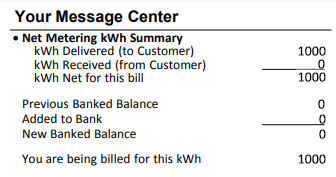Billing and usage for renewable energy customers
PPL Electric UtilitiesAn Explanation Of Net Metering For Solar Panels And Other Generation
Energy delivered to you − Energy received from you = Net Energy
Customers who return energy to the grid are known as net metering customers.
Compensation
- PPL generally compensates net metering customers once per year, in
- May. If you have a different supplier, ask if or how you will be compensated. Not all electricity suppliers participate in net metering, and may not compensate customers.
Measuring Electricity
- PPL’s meter does not measure how much electricity your solar panels or other system produce for your use.
- PPL measures how much electricity we deliver to you, and how much we receive from you.
Billing
- Even if you return more electricity to the grid than you use, you will still receive an electric bill for basic electric service.
How you are compensated depends on your electricity supplier. If PPL is your electricity supplier, you generally will receive a check in the mail from us each May for excess energy you return to the grid. This payment is based on the price to compare at the time of the payout. The complete list of payout events are:
- Annually in May.
- Change from PPL to another supplier.
- Change from one supplier to another.
- Change from a supplier to PPL.
- Rate schedule change, such as going from a residential rate to a time-of-use rate.
- If you stop your electric service.
If you have an alternate supplier, ask if and how you will be compensated. Remember: Not all electricity suppliers participate in net metering, and may not compensate customers for electricity they return to the power grid. Customers who choose an electricity supplier must check with that supplier to see if it offers net metering service. You can view your current supplier and contact information on your electricity bill or by logging in to your PPL account.
If your supplier does not offer compensation, then PPL will credit you for the distribution portion of the excess kilowatt-hours each month. Your supplier will bill you for their regular charges for your usage. You will not receive a payment for the kWh you returned to the grid.
Usage
Customers who have advanced meters can see how much energy they are receiving and delivering on a daily and hourly basis. All customers will be receiving these new meters. Customers with older meters will see only their net energy usage on our website.
In the daily and hourly usage chart:
- Green represents how much energy PPL received from you. (How much you generated and sent back to the grid)
- Blue represents how much energy we delivered to you.
- Net represents the difference between delivered and received.
You’ll also see average temperature. The temperature scale is represented by degrees on the right-hand side of the graph.
Daily Usage
Usage by hour on one day
About Your Electric Bill
PPL Electric UtilitiesReceiving an electric bill
You will still receive an electric bill after your system is installed. We need to have the same power lines, metering equipment and facilities in place to serve you – whether we’re needed as a backup source of supply, or to take and distribute excess power you produce.
Information comes from your electric meter
Once your renewable energy application is approved and installed, you will see new information on your electricity bill. The information comes from your electric meter, and not directly from your solar panels or other renewable energy system.
Measuring you electricity
PPL’s meter does not measure how much electricity your solar panels or other system produces. We measure how much electricity we deliver to you, and how much we receive from you.
How to read your bill
PPL Electric UtilitiesPPL compensates net metering customers once per year, in May. Each month, we add or subtract energy to your banked balance.
While your own generation meter will measure the total amount you are generating, PPL’s meter will only measure the amount you return from the grid, or the amount you get from the grid. Customers with new advanced meters will see a breakdown of how much electricity was delivered to you and how much was received from you. Customers with traditional meters will see their net energy usage.
Example 1

- Home uses 1,400 kWh total
- Solar panels generate 400 kWh, and customer uses this energy
- Electric meter reads 1,000 kWh delivered to customer and 0 received from customer
- Bill is for 1,000 net kWh, plus standard distribution charges
- Customer has no energy in the banked balance
Example 2
- Home uses 800 kWh total
- Solar panels generate 960 kWh.
- Customer uses some of this energy, and returns some to the grid.
- Electric meter reads 0 kWh delivered to customer and 160 kWh received from customer
- Bill is for 0 usage, plus standard distribution charges.
- 160 kWh is added to the customer’s existing banked balance for future use or annual payout.
Renewable Energy Credits
Renewable energy credits, or renewable energy certificates, are part of the world of renewable generation and serve as a sort of currency for renewable energy markets.
RECs represent the attributes of renewable electricity generation, things such as greenhouse gas reduction that are outside of the electricity itself. RECs have a monetary value and can be bought and sold between buyers and sellers from generation to the final point of application or use at a facility. The federal government and the Pennsylvania Public Utility Commission advise that consumers or organizations with on-site renewable electricity systems should be clear about who owns the RECs produced by their system.


